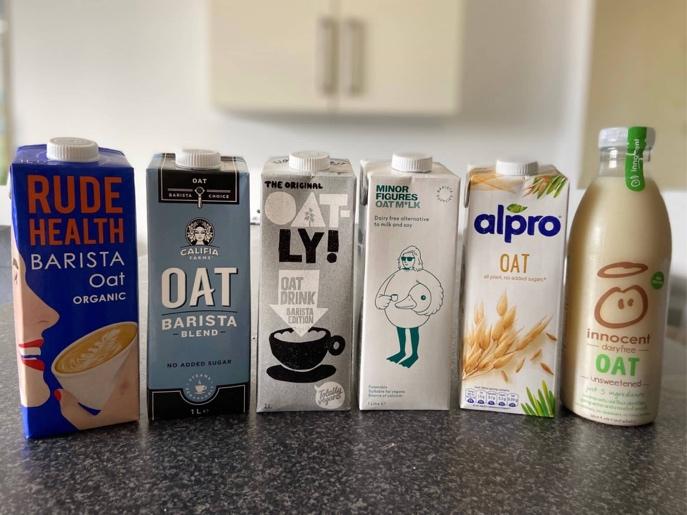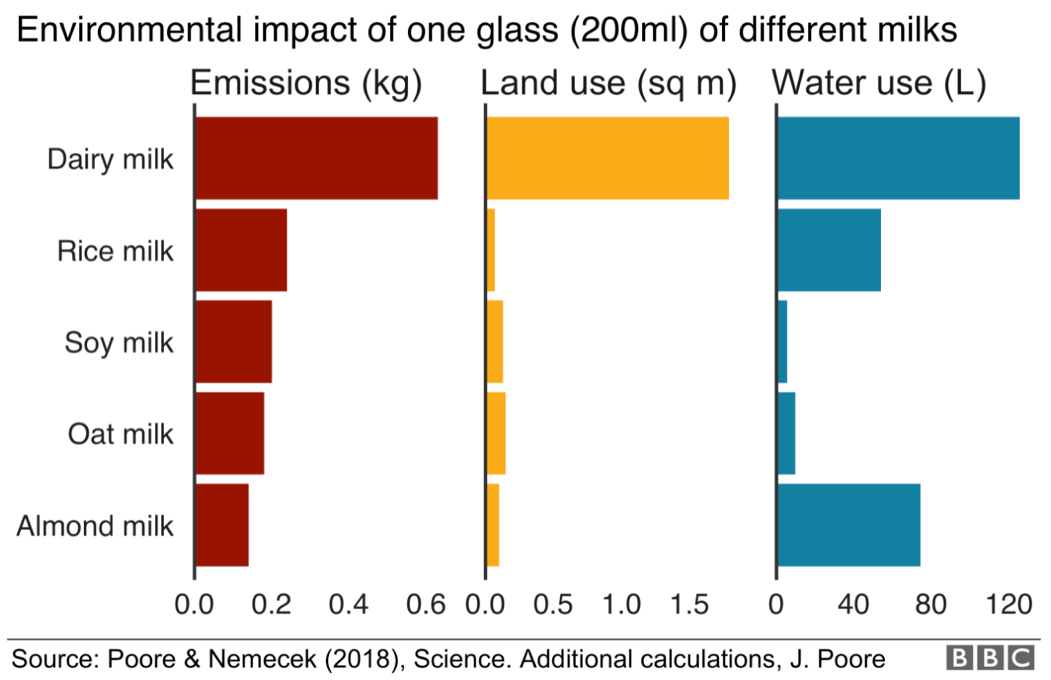Navigating Alternative and Non-Dairy Milks
What is the best alternative milk?
This seems to be the question on everyone’s mind. One minute it’s almond, the next soy, and then oat. The list goes on and the fake news proliferates. Every day I see a new tweet about how we shouldn’t be drinking almond milk or about how soy milk certifications are falsified. This minefield is hard to navigate, and social media doesn’t make it any easier, so we’re here to outline the real truths about non-dairy milks and hopefully help you make a more sustainable choice.
Let’s start with Soy Milk.
Soy milk has been the most popular non-dairy substitute for decades, and it is the best high-protein milk alternative. Most brands will also be fortified with calcium and vitamin D, and so the profile of soy milk often closely resembles that of cow’s milk. A study by Oxford researcher Joseph Poore looked at the environmental footprints of non-dairy milks and rated them with regard to their environmental impact. For this, Soy milk came third. Somewhat impressive considering the stories you hear about it on the internet. Something to keep in mind, however, is that soy can have a big localised impact, depending on where it’s from. For example, soy grown in Brazil contributes massively to local deforestation, whilst soy grown in North America and China has less of a local impact on deforestation. A key takeaway here is to look at the labels, check where the soy milk has originated from, and check for responsible certifications on the bottle. Alpro, for example, commits to only buying their soy directly from the farmer so it is easier to trace their origins, and so most of the soy that goes into their milk is from France. Information like this is easy to find out, and can be located either on the product directly or with a quick google search for Alpro’s social responsibility or environmental commitment.
Oat Milk, is also high in protein, and it is packed full of fibre. It is comprised of whole oat grains and water; simple and effective. There are lots of oat milk brands to choose from, but a recent review by The Vegan Review, placed Minor Figures Oat Milk at the top. Minor Figures is comprised of 10% Oats, Calcium Supplements, Salt, Water, and Rapeseed Oil. Oat milk was rated second by Poore and his peers for its environmental impact; using 0.9kg of carbon per litre, compared with 3.2kg per litre used by dairy milk. Further to this, oat milk needs 48 litres of water per pint of milk produced, whilst still a lot, Dairy milk need 628 litres of water per pint of milk. Rather scary to think about.

Almond Milk is a notorious water-hogger, but even Almond milk uses less water than dairy, racking in at 371 litres of water needed per pint of milk. Essentially, this nut milk is made from water and ground almonds. It is also predominantly grown in California, and this is where the problems start to occur. 80% of the world’s almonds are produced in California, under intensive farming practices, where trees are planted closer together, more pesticides are sprayed, and they are drowned in irrigation water. These intensive methods are spreading, and they have been adopted across most of Spain now as well. Like soy milk, almond milk can have a varying environmental impact, depending on where it is produced and depending on the quantity of fertiliser and water used. This is hard to determine on a bottle of Almond milk, but your best bet is to assess the label carefully and consider where the almonds for your drink have originated.
Coconut milk is one of the newest non-dairy milks out there. It is a good alternative if you’re after something creamy and sweet, as well as a boost of Vitamin D and Vitamin B-12. It does, however, lack in calcium and protein so if that’s what you’re looking for, maybe consider Soy milk instead.
Rice milk is another alternative milk on offer. It has a more natural flavour than other alternative milks, and when fortified it can contain similar amounts of calcium and vitamin D as cow’s milk. It has also been rated by Poore as 4th best for carbon emissions, at 1.2kg of carbon required per 1 litre of milk.
Now this has been a bit of a whistle-stop-tour and you may be thinking, well this is no clearer. Hopefully you’ve learnt something, but there is also a graph from Poore’s study that summarises environmental impacts of non-dairy milks, if you wanted to put these eco issues into perspective.

As you can see, all non-dairy milks come out better than cow’s milk. Technically Soy and Oat milk come out on top, but it’s all about balance. Too much pressure on these alternatives, will ultimately increase the pressure for intensive farming practices, and this too is not ideal. For most plant milks, the environmental impact of the crop itself is relatively low, so it is the packaging and the transport that become the dominant component in environmental impact. This is the case for oat and soy milk. Another key thing to remember when shopping for non-dairy milk is that organic is (unsurprisingly) better. A 2012 review by Hanna Tuomisto and colleagues in Finland, found that organic farming more generally had positive impacts on the environment per unit area.
Irrespective of these nuances, I think one of the biggest issues in the non-dairy milk industry is transparency. Companies need to be honest. They need their ingredient labels to be clear, and to outline the origin of certain ingredients, as well as highlighting sustainable conventions that they have signed up to. As well as that, it is important that their websites provide up to date and accurate information, not only about their environmental impact, but also about what is currently going on with their process, and what they plan to do to improve in the future. This transparency is key, and it is important in helping people make educated decisions about what milk they buy. This is where Sustained steps in too, offering people transparency on the food and drink they purchase, and educating shoppers to make sustainable choices in the supermarket.
References
https://earth911.com/how-and-buy/good-better-best-the-climate-impacts-of-milks/
https://www.statista.com/statistics/1092652/volume-of-water-to-produce-a-liter-of-milk-by-type/
https://theveganreview.com/whats-the-best-oat-milk-in-the-uk-we-tested-6-in-6-ways-to-find-out/
https://www.statista.com/statistics/1092652/volume-of-water-to-produce-a-liter-of-milk-by-type/
https://www.bbc.com/future/article/20200207-which-milk-alternative-should-we-be-drinking
Reducing food’s environmental impacts through producers and consumers
-1.png?length=384&name=Blog%20header%20(5)-1.png)
.png?length=384&name=Blog%20header%20(7).png)